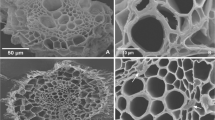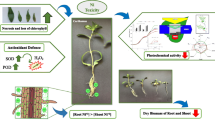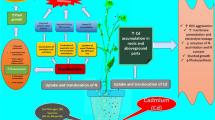Abstract
The present study was conducted to investigate the growth performance, physiology, leaf epidermis ultra-structure, metal accumulation, and antioxidant properties of Oxalis corniculata grown in soil contaminated with nickel (Ni) and chromium (Cr). The different levels of nickel (Ni10, Ni20, Ni40, and Ni50 mg/kg soil) and chromium (Cr10, Cr15, Cr30, and Cr40 mg/kg soil) were administered to the soil 15 days after sowing (DAS), i.e., two-leaf stage of the test plants. The sampling was done 60 and 90 days after sowing (DAS). Low levels of both metals (Ni10 and 20 and Cr10) enhanced growth, caused no abnormality in leaf epidermis structure, and slightly decreased the activity of antioxidant enzymes and the proline content. Ni40–50 and Cr15–40 application caused a considerable and significant decline in growth characteristics and activity of nitrate reductase. Ultra-structural abnormalities of the leaf epidermis were also observed. Higher Ni and Cr levels increased the activity of superoxide dismutase, peroxidases, and catalase and proline content manyfold. Cr was found to be more toxic than Ni. Translocation factor (TF) values for Ni (1.023) and Cr (0.934) indicated that Ni was more efficiently transferred from root to shoot. Possible implications of these findings for community dynamics, ecosystem functions, and ecosystem services are also discussed.







Similar content being viewed by others
Data Availability
Corresponding author will provide data on genuine request.
References
Adriano DC (1986) Trace elements in the terrestrial environment. Springer-Verlag, New York. https://doi.org/10.1007/978-1-4757-1907-9
AL-Huqail A, El-bondkly MA (2022) Improvement of Zea mays L. growth parameters under chromium and arsenic stress by the heavy metal-resistant Streptomyces sp. NRC21696. Int J Environ Sci Technol 19:5301–5322. https://doi.org/10.1007/s13762-021-03532-7
Alloway BJ (1990) Heavy Metals in Soils (Ed. Alloway B. J. and Blackie), Glasgow
Amjad M, Raza H, Murtaza B, Abbas G, Imran M, Shahid M, Naeem MA, Zakir A, Iqbal MM (2019) Nickel toxicity induced changes in nutrient dynamics and antioxidant profiling in two maize (Zea mays L.) hybrids. Plants 9:5. https://doi.org/10.3390/plants9010005
Andresen E, Peiter E, Kupper H (2018) Trace metal metabolism in plants. J Exp Bot 69:909–954. https://doi.org/10.1093/jxb/erx465
Arif N, Yadav V, Singh S, Singh S, Ahmad P, Mishra RK, Sharma S, Tripathi DK, Dubey NK, Chauhan DK (2016) Influence of high and low levels of plant-beneficial heavy metal ions on plant growth and development. Front Environ Sci 4:69. https://doi.org/10.3389/fenvs.2016.00069
Asati A, Pichhode M, Nikhil K (2016) Effect of heavy metals on plants: an overview. Int J Appl Innov Eng Manag 5:56–66
Aslam M, Aslam A, Sheraz M, Ali B, Ulhassan Z, Najeeb U, Zhou W, Gill RA (2020) Lead toxicity in cereals: mechanistic insight into toxicity, mode of action, and management. Front Plant Sci 11:587785. https://doi.org/10.3389/fpls.2020.587785
Bashir MA, Naveed M, Ahmad Z, Gao B, Mustafa A, Núñez-Delgado A (2020) Combined application of biochar and sulfur regulated growth, physiological, antioxidant responses and Cr removal capacity of maize (Zea mays L.) in tannery polluted soils. J Environl Manage 259:110051. https://doi.org/10.1016/j.jenvman.2019.110051
Bates LS, Waldren RT, Tearse ID (1973) Rapid determination of free proline from water stress studies. Plant Soil 39:205–207. https://doi.org/10.1007/BF00018060
Beauchamp C, Fridovich I (1971) Superoxide dismutase improved assays and assay applicable to acrylamide gels. Ann Biochem 44:276–287. https://doi.org/10.1016/0003-2697(71)90370-8
Chance B, Maehly AC (1955) Assay of catalase and peroxidase. Methods Enzymol 2:764–775. https://doi.org/10.1016/S0076-6879(55)02300-8
Chen M, Zhang X, Jiang P, Liu J, You S, Lv Y (2022) Advances in heavy metals detoxification, tolerance, accumulation mechanisms, and properties enhancement of Leersia hexandra Swartz. J Plant Interact 17:766–778. https://doi.org/10.1080/17429145.2022.2096266
Christou A, Georgiadou EC, Zissimos AM et al (2021) Uptake of hexavalent chromium by tomato (Solanum lycopersicum L.) plants and mediated effects on their physiology and productivity, along with fruit quality and safety. Environ Exp Bot 189:104564. https://doi.org/10.1016/j.envexpbot.2021.104564
Costa JM, da Costa JGDR, de Almeida Neto AF (2022) Techniques of nickel (II) removal from electroplating industry wastewater: Overview and trends. J Water Process Eng 46:102593. https://doi.org/10.1016/j.jwpe.2022.102593
Cui S, Zhou Q, Chao L (2007) Potential hyper-accumulation of Pb, Zn, Cu and Cd in endurant plants distributed in an old smeltery, northeast China. Environ Geology 51:1043–1048. https://doi.org/10.1007/s00254-006-0373-3
da Conceicao Gomes MA, Hauser-Davis RA, Suzuki MS, Vitoria AP (2017) Plant chromium uptake and transport, physiological effects and recent advances in molecular investigations. Ecotoxicol Environ Saf 140:55–64. https://doi.org/10.1016/j.ecoenv.2017.01.042
Emamverdian A, Ding Y, Mokhberdoran F, Xie Y (2015) Heavy metal stress and some mechanisms of plant defense response. Sci World J. Article ID 756120. https://doi.org/10.1155/2015/756120
Favas PJ, Pratas J, Varun M, D’Souza R, Paul MS (2014) Phytoremediation of soils contaminated with metals and metalloids at mining areas: potential of native flora. Environ Risk Assess Soil Contam 3:485–516. https://doi.org/10.5772/57469
Ghosh AB, Bajaj JC, Hassan R, Singh D (1988) Soil and water testing methods, A lab manual. New Delhi: IARI, pp 31–36
Golbarg H, Mehdipour Moghaddam MJ (2021) Antibacterial potency of medicinal plants including Artemisia annua and Oxalis corniculata against multi-drug resistance E. coil. Bio Med Res Int. Article ID 9981915. https://doi.org/10.1155/2021/9981915
Hamim H, Apriani R, Saprudin D, Sulistyaningsih YC (2020) Growth, photosynthesis and proline accumulation of metal-accumulator weeds. Biotropia-Southeast Asian J Trop Biol 27:256–270. https://doi.org/10.11598/btb.0.0.0.1200
Hassan MU, Chatha MU, Khan I, Chatha MB, Amer M, Nawaz M, Ali A, Khan MA, Khan TA (2019) Nickel toxicity in plants: reasons, toxic effects, tolerance mechanisms and remediation possibilities—a review. Environ Sci Pollut Res 26:12673–12688. https://doi.org/10.1007/s11356-019-04892-x
Hassan S, Bhat SA, Kumar V, Ganai BA, Ameen F (2022) Phytoremediation of heavy metals: an indispensable contrivance in green remediation technology. Plants 11:1255. https://doi.org/10.3390/plants11091255
Hayat S, Khalique G, Irfan M, Wani AS, Tripathi BN, Ahmad A (2012) Physiological changes induced by chromium stress in plants: an overview. Protoplasma 249:599–611. https://doi.org/10.1007/s00709-011-0331-0
Jalal A, de Oliveira Junior JC, Ribeiro JS, Fernandes GC, Mariano GG, Trindade VD, Dos Reis AR (2021) Hormesis in plants: physiological and biochemical responses. Ecotoxicol Environ Saf 207:111225. https://doi.org/10.1016/j.ecoenv.2020.111225
Jaworski EG (1971) Nitrate reductase assay in intact plant tissues. Biochem Biophys Res Comm. https://doi.org/10.1016/S0006-291X(71)80010-4
Kaur S, Kaur G, Singh J (2017) Phytochemical screening and biological Oxalis corniculata. Res J Chem 7:26–32
Khan A, Khan AA, Irfan M (2022) Effects of different concentrations of nickel (Ni) on the vegetative and reproductive growth parameters of Nigella sativa L. Gesunde Pflanzen. https://doi.org/10.1007/s10343-022-00733-z
Kinuthia GK, Ngure V, Beti D, LugaliaR WA, Kamau L (2020) Levels of heavy metals in wastewater and soil samples from open drainage channels in Nairobi, Kenya: community health implication. Sci Rep 10:8434. https://doi.org/10.1038/s41598-020-65359-5
Kotapati KV, Palaka BK, Ampasala DR (2017) Alleviation of nickel toxicity in finger millet (Eleusine coracana L.) germinating seedlings by exogenous application of salicylic acid and nitric oxide. Crop J 5:240–250. https://doi.org/10.1016/j.cj.2016.09.002
Kumar O, Singh SK, Patra A, Latare A, Yadav SN (2021) A comparative study of soil and foliar nickel application on growth, yield and nutritional quality of barley (Hordeum Vulgare L.) grown in Inceptisol. Commun Soil Sci Plant Anal 52:1207–1223. https://doi.org/10.1080/00103624.2021.1879119
Labudda M, Dziurka K, Fidler J et al (2022) The alleviation of metal stress nuisance for plants—a review of promising solutions in the face of environmental challenges. Plants 11:2544. https://doi.org/10.3390/plants11192544
Li B, Chen D, Yang Y, Li X (2019) Effects of soil properties on accumulation characteristics of copper, manganese, zinc and cadmium in Chinese turnip. Plant Divers 41:340–346. https://doi.org/10.1016/j.pld.2019.06.006
Liu ZC, Wang LA (2014) A plant species (Trifolium repens) with strong enrichment ability for mercury. Ecol Eng 70:349–350. https://doi.org/10.1016/j.ecoleng.2014.06.029
Liu Z, Wang LA, Ding S, Xiao H (2018) Enhancer assisted-phytoremediation of mercury-contaminated soils by Oxalis corniculata L., and rhizosphere microorganism distribution of Oxalis corniculata L. Ecotoxicol Environ Saf 160:171–177. https://doi.org/10.1016/j.ecoenv.2018.05.041
Mabberley DJ (2008) Mabberley’s Plant-book: a portable dictionary of higher plants. Cambridge University Press, Cambridge
Mackinney G (1941) Absorption of light by chlorophyll solutions. J Biol Chem 140:315–332. https://doi.org/10.1016/S0021-9258(18)51320-X
Makuch-Pietras I, Grabek-Lejko D, Gorka A, Kasprzyk I (2023) Antioxidant activities in relation to the transport of heavy metals from the soil to different parts of Betula pendula (Roth.). J Biol Eng 17:1–25. https://doi.org/10.1186/s13036-022-00322-8
Mandal M, Sarkar M, Khan A, Biswas M, Masi A, Rakwal R, Agrawal GK, Srivastava A, Sarkar A (2022) Reactive oxygen species (ROS) and reactive nitrogen species (RNS) in plants–maintenance of structural individuality and functional blend. Adv Redox Res 100039. https://doi.org/10.1016/j.arres.2022.100039
Meena M, Divyanshu K, Kumar S, Swapnil P, Zehra A, Shukla V, Yadav M, Upadhyay RS (2019) Regulation of L-proline biosynthesis, signal transduction, transport, accumulation and its vital role in plants during variable environmental conditions. Heliyon 5:e02952. https://doi.org/10.1016/j.heliyon.2019.e02952
Meuwly P, Rauser WE (1992) Alteration of thiol pools in roots and shoots of maize seedling exposed to cadmium: adaptation and developmental cost. Plant Physiol 99:8–15. https://doi.org/10.1104/pp.99.1.8
Nguyen NL, Vu CT, To HM, Pham HN, Nguyen HD, Nguyen TD, Nguyen Thi KO (2020) The interactions among the heavy metals in soils and in weeds and their antioxidant capacity under the mining activities in Thai Nguyen province, Vietnam. J Chem 1–12. https://doi.org/10.1155/2020/8010376
Orcen N, Nazarian G, Gharibkhani M (2013) The responses of stomatal parameters and SPAD value in Asian tobacco exposed to chromium. Polish J Environ Stud 22:1441–1447
Patil VN, Dadlani M (2009) Tetrazolium test for seed viability and vigour, in Handbook of seed testing, 209–241. http://seednet.gov.in/pdffiles/chapter%2014.pdf. Accessed 18 Nov 2022
R Development Core Team (2011) A language and environment for statistical computing. R Foundation for Statistical Computing, Vienna, Austria. http://www.R-project.org/
Rana V, Ram S, Nehra K (2017) Review proline biosynthesis and its role in abiotic stress. Int J Agric Innovat Res 6:473–478
Ribeiro AT, de Oliveira VP, de Oliveira Barros Junior U et al (2020) 24-Epibrassinolide mitigates nickel toxicity in young Eucalyptus urophylla S.T. Blake plants: nutritional, physiological, biochemical, anatomical and morphological responses. Ann For Sci 77:1–19. https://doi.org/10.1007/s13595-019-0909-9
Riyazuddin R, Nisha N, Ejaz B, Khan MIR, Kumar M, Ramteke PW, Gupta R (2021) A comprehensive review on the heavy metal toxicity and sequestration in plants. Biomolecules 12:43. https://doi.org/10.3390/biom12010043
Rizvi A, Khan MS (2019) Heavy metal-mediated toxicity to maize: oxidative damage, antioxidant defence response and metal distribution in plant organs. Int J Environ Sci Technol 16:4873–4886. https://doi.org/10.1007/s13762-018-1916-3
Rucińska-Sobkowiak R (2016) Water relations in plants subjected to heavy metal stresses. Acta Physiol Plant 38:1–13. https://doi.org/10.1007/s11738-016-2277-5
Zengin FK, Munzuroglu O (2005) Effects of some heavy metals on content of chlorophyll, proline and some antioxidant chemicals in bean (Phaseolus vulgaris L.) seedlings. Acta Biol Crac Ser Bot 47:157–164
Ruiz-Huerta EA, Armienta-Hernandez MA, Dubrovsky JG, Gomez-Bernal JM (2022) Bioaccumulation of heavy metals and As in maize (Zea mays L) grown close to mine tailings strongly impacts plant development. Ecotoxicology. https://doi.org/10.1007/s10646-022-02522-w
Samantaray S, Rout GR, Das P (1998) Role of chromium on plant growth and metabolism. Acta Physiol Plant 20:201–212. https://doi.org/10.1007/s11738-998-0015-3
Samreen S, Khan AA (2017) Parthenium hysterophorus: growth response to chromium and nickel application and phytoremediation potential. Haya: Saudi. J Life Sci 2:262–268
Samreen S, Khan AA, Khan MR, Ansari SA, Khan A (2021) Assessment of phytoremediation potential of seven weed plants growing in chromium- and nickel-contaminated soil. Wat Air and Soil Poll 232:1–18. https://doi.org/10.1007/s11270-021-05124-0
Sarkar T, Ghosh P, Poddar S, Choudhury S, Sarkar A, Chatterjee S (2020) Oxalis corniculata Linn. (Oxalidaceae): a brief review. J Pharmacog Phytochem 9:651–655
Saud S, Wang D, Fahad S, Javed T, Jaremko M, Abdelsalam NR, Ghareeb RY (2022) The impact of chromium ion stress on plant growth, developmental physiology, and molecular regulation. Front Plant Sci 13:994785. https://doi.org/10.3389/fpls.2022.994785
Sharma RA, Kumari A (2014) Phytochemistry, pharmacology and therapeutic application of Oxalis corniculata Linn.–a review. Int J Pharm Pharmaceut Sci 6:6–12
Sharma A, Kapoor D, Wang J, Shahzad B, Kumar V, Bali AS, Jasrotia S, Zheng B, Yuan H, Yan D (2020) Chromium bioaccumulation and its impacts on plants: an overview. Plants 9:100. https://doi.org/10.3390/plants9010100
Sharma P, Chouhan R, Bakshi P, Gandhi SG, Kaur R, Sharma A, Bhardwaj R (2022) Amelioration of chromium-induced oxidative stress by combined treatment of selected plant-growth-promoting rhizobacteria and earthworms via modulating the expression of genes related to reactive oxygen species metabolism in Brassica juncea. Front Microbiol 13. https://doi.org/10.3389/fmicb.2022.802512
Sheetal KR, Singh SD, Anand A, Prasad S (2016) Heavy metal accumulation and effects on growth, biomass and physiological processes in mustard. Indian J Plant Physiol 21:219–223. https://doi.org/10.1007/s40502-016-0221-8
Sherin G, Aswathi KR, Puthur JT (2022) Photosynthetic functions in plants subjected to stresses are positively influenced by priming. Plant Stress 100079. https://doi.org/10.1016/j.stress.2022.100079
Singh S, Sinha S (2004) Scanning electron microscopic studies and growth response of the plants of Helianthus annuus L. grown on tannery sludge amended soil. Environ Int 30:389–395. https://doi.org/10.1016/j.envint.2003.09.006
Souahi H, Chebout A, Akrout K, Massaoud N, Gacem R (2021) Physiological responses to lead exposure in wheat, barley and oat. Environ Challenges 4:100079. https://doi.org/10.1016/j.envc.2021.100079
Srikanth M, Swetha T, Veeresh B (2012) Phytochemistry and pharmacology of Oxalis corniculata Linn.: a review. Int J Pharmaceut Sci Res 3:4077–4085
Subrahmanyam D (2008) Effects of chromium toxicity on leaf photosynthetic characteristics and oxidative changes in wheat (Triticum aestivum L.). Photosynthetica 46:339–345. https://ps.ueb.cas.cz/pdfs/phs/2008/03/03.pdf
Usman K, Al-Ghouti MA, Abu-Dieyeh MH (2019) The assessment of cadmium, chromium, copper, and nickel tolerance and bioaccumulation by shrub plant Tetraena qataranse. Sci Rep 9:5658. https://doi.org/10.1038/s41598-019-42029-9
Viehweger K (2014) How plants cope with heavy metals. Bot Stud 55:35. https://doi.org/10.1186/1999-3110-55-35
Whiting SN, Reeves RD, Richards D, Johnson MS, Cooke JA, Malaisse F, Baker AJ (2004) Research priorities for conservation of metallophyte biodiversity and their potential for restoration and site remediation. Restor Ecol 12:106–116. https://doi.org/10.1111/j.1061-2971.2004.00367.x
Zainab N, Amna Khan AA, Azeem MA et al (2021) PGPR-mediated plant growth attributes and metal extraction ability of Sesbania sesban L. in industrially contaminated soils. Agronomy 11:1820. https://doi.org/10.3390/agronomy11091820
Acknowledgements
The authors are grateful to the section of Ecology and Environmental Botany, Department of Botany, A.M.U, Aligarh, for providing the necessary facilities to carry out this work.
Author information
Authors and Affiliations
Contributions
A.A.K. supervised and directed the experiment. S.S. carried out the experiment, analyzed bioinformatics data, and drafted the manuscript. A.A.K and A.K revised the manuscript. A.A.K approved the final manuscript.
Corresponding author
Ethics declarations
Competing Interests
The authors declare no competing interests.
Additional information
Publisher's Note
Springer Nature remains neutral with regard to jurisdictional claims in published maps and institutional affiliations.
Rights and permissions
Springer Nature or its licensor (e.g. a society or other partner) holds exclusive rights to this article under a publishing agreement with the author(s) or other rightsholder(s); author self-archiving of the accepted manuscript version of this article is solely governed by the terms of such publishing agreement and applicable law.
About this article
Cite this article
Samreen, S., Khan, A.A. & Khan, A. Physiological, Ultrastructural, and Antioxidant Modulation in Response to Nickel and Chromium Induced Oxidative Stress and Their Accumulation in Oxalis corniculata L.. J Soil Sci Plant Nutr 23, 3508–3520 (2023). https://doi.org/10.1007/s42729-023-01267-7
Received:
Accepted:
Published:
Issue Date:
DOI: https://doi.org/10.1007/s42729-023-01267-7




